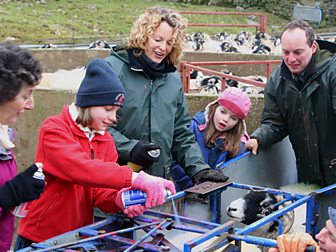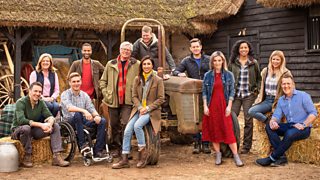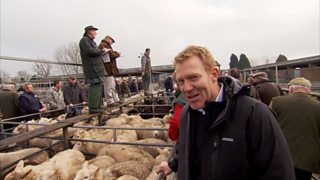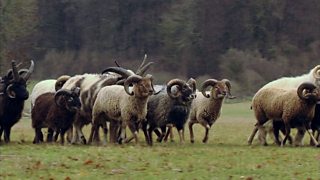
Series 2
Kate Humble and Adam Henson follow the life and death drama of lambing season live from a sheep farm in Cumbria.
On iPlayer
Not available
Supporting Content
Introduction
Kate Humble and Adam Henson follow the life and death drama of lambing season live from a sheep farm in Cumbria.
Lambing Live returned to 91热爆 Two for a second series in April 2011. The previous Spring, Kate Humble and Adam Henson tested their shepherding skills on a lowland farm in Wales, this time the life and death drama of lambing headed for the hills in Cumbria.
There was a new farm and a new family - the Marstons - three generations who鈥檝e made their lives in the remote and sometimes harsh world of hill farming. Here, much of the lambing is done outdoors and flocks are brought down to the 'in bye' land near the farmhouse to lamb under the shepherd's watchful eye.
By now Kate Humble had a good grasp of the shepherding basics but she soon discovered that hill sheep demand a new set of skills and a whole new language. Kate was apprenticed to the Marstons. She helped with the 'fell gather' (bringing the sheep down from the common land on the fells), learned about 'hefting' (teaching sheep to stay on the fell) and discovered what went into producing a prize Swaledale sheep.
In April 2011, Kate and Adam joined the Marstons for the daily drama of lambing. There were storms, high winds, torrential rain and plenty of lambs to look after.The Marstons
The Marstons are a sheep farming dynasty spanning three generations, born and bred in the picturesque Eden Valley on the very Eastern edge of Cumbria. Each Spring they lamb around 700 sheep which are a mixture of pure bred Swaledales, Beltexes, North of England Mules and Blue Faced Leicesters. They also breed cattle. Plus there鈥檚 Hope and Lynne, the sheepdogs and a few assorted chickens.
Andrew works closely with his father Donald to run the farm. They also live next door to each other on the edge of the farmyard. Andrew, his wife Rachel and their three daughters, Catherine, Abigail and Olivia live in a converted barn adjoining the original farmhouse which Donald and Andrew's mum, Christine, call home.
When the sheep need to be gathered in from the fell or prepared for sale, everyone mucks in. At lambing time, Catherine and Abigail help clean the pens and feed the sheep, while Christine is in charge of tagging. Lambing outdoors means there鈥檚 a lot of ground to cover and everyone helps out. For the Marstons, farming is a real family affair.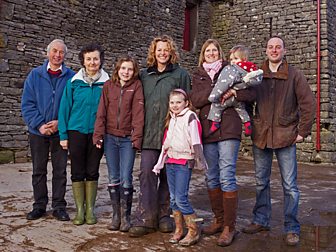
The fell gather
Like most hill farmers, the Marstons' sheep spend most of their time on the open fell. Close to the farmhouse are a patchwork of small fields known as the 'inbye'. These fields are typically divided by dry stone walls.
Beyond the inbye the land rises up to the open fell. Here there are no walls or fences and the sheep graze freely. Each farmer's sheep has their own patch or 'heft' which is an area they will always return to. Ewes will teach their lambs the heft and this knowledge is passed down the generations.
The sheep need to be brought down from the fell for tupping (when the ewes are put with the rams) and lambing. In October, Kate helped the family with what鈥檚 known as a 'fell gather'.
Andrew and Donald headed off on quads to gather sheep from the farthest corners of the fell. They use their dogs to shepherd the sheep, first collecting small groups, then gradually bringing all the sheep together at the bottom of the fell. It's an amazing spectacle and a real skill. Kate, Rachel and the children then all joined together to walk the sheep the last few miles to the farm.
Once the sheep are back down on the farm they need to be sorted. Andrew and Donald will usually have most of their own sheep but they will also have collected a few of their neighbours. The Marstons always need to sort or 'shed' them and then make sure any strays are returned.
All the sheep are marked with 'smit marks'. These are coloured marks on their fleeces which are often combined with brands on their horns. Each farm has its own distinctive smit mark, so the farmers can tell who the sheep belong to. These marks are published in a Shepherd's guide and most haven't changed for generations.
Kate helped to sort the sheep, working the gates under Andrew's watchful eye to make sure that all the sheep ended up in the right place. Once sorted, the sheep were put out into the lush fields of the inbye to get them into the best possible condition for tupping. Now all they had to do was eat well and wait for the rams!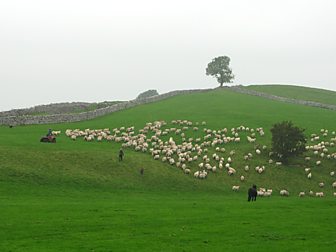
Scanning
Like many commercial farmers, the Marstons scan their ewes so they know exactly how many lambs they鈥檙e expecting. This way they can make sure that they provide extra food to those ewes having twins or triplets rather than those having a single lamb.
The Marstons bring in a professional scanner who uses an ultrasound to check each and every ewe. Then all the family help to mark the sheep up. The Marstons use one blue spot for a single, a red spot for twins and yellow for triplets.